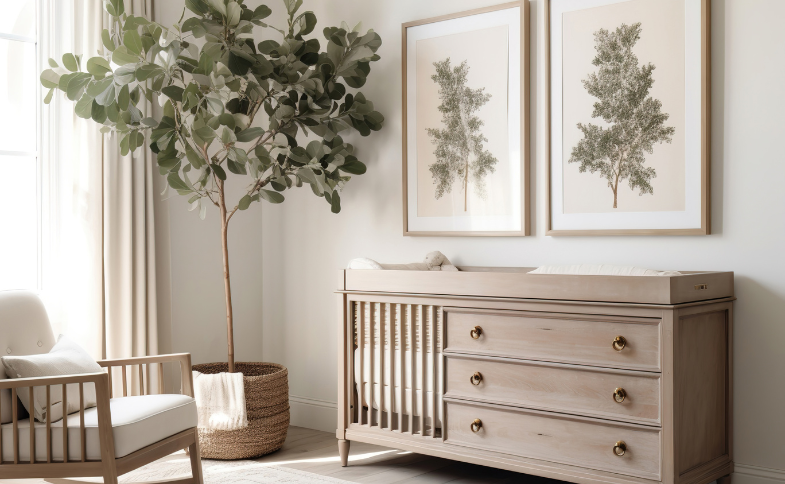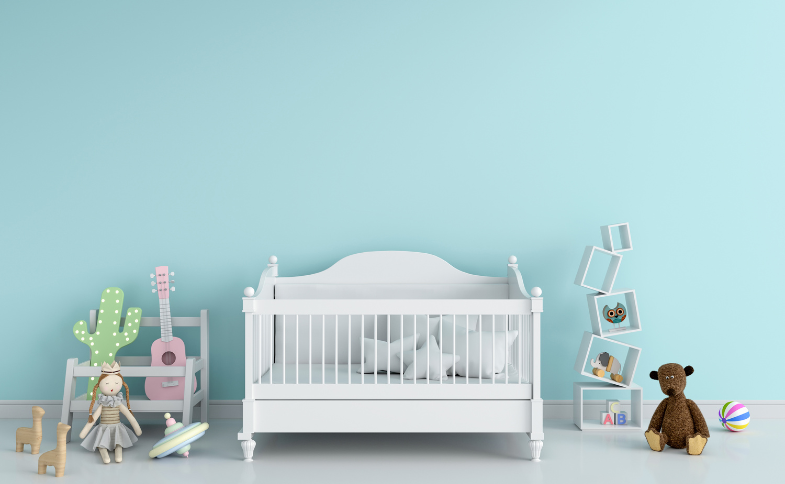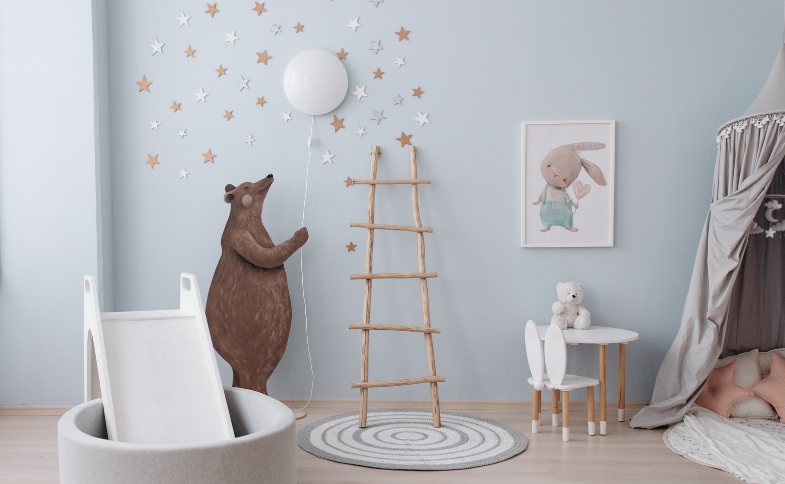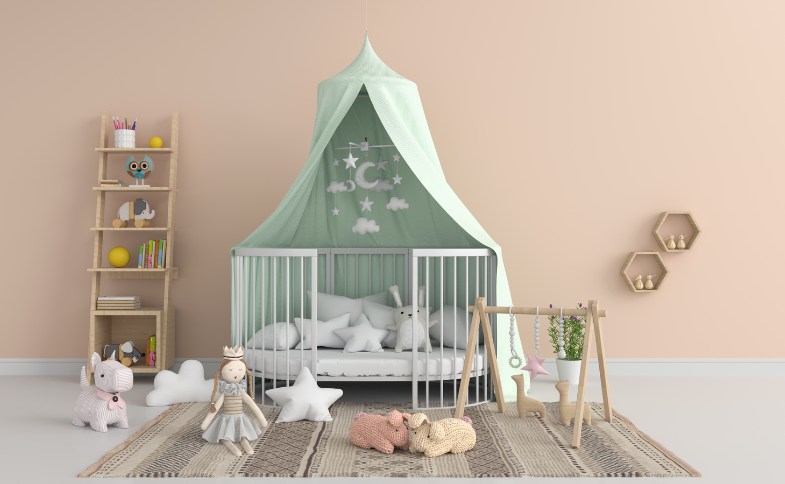How To Build A Sustainable Nursery: Tips For Eco-Friendly Parents
A sustainable nursery is a wonderful way for eco-concious parents to provide an environmentally friendly space for their little ones. It’s just great for both your kiddo and the planet! And the best part is that there are many ways to make your nursery eco-friendly.
In this guide, we'll explore practical tips to help you build a sustainable nursery without compromising on style or comfort. Here are some tips to help you create a sustainable, earth-friendly nursery.

Choosing Sustainable Furniture
When buying furniture and decor for the nursery, seek out products made from renewable, recycled, or upcycled materials. Here’s how to do it:
1. Go for Solid Wood:
Your nursery furniture is the backbone of your nursery, so you have to get this part right. When selecting nursery furniture, choose pieces made from solid, sustainably sourced wood. Look for certifications such as FSC (Forest Stewardship Council) to ensure the wood comes from responsibly managed forests.
2. Convertible Furniture:
Invest in convertible furniture that grows with your child. Cribs that can be transformed into toddler beds or dressers that can serve as changing tables and so on will reduce the need for additional furniture over time. This will not only be cheaper for you in the long run but also help reduce clutter in your little one’s nursery.
3. Second-Hand Finds:
Consider buying second-hand furniture to give it a new life. Thrift stores, online marketplaces, and consignment shops often have affordable and eco-friendly options. We talk more about this in our episodes on cutting your nursery room costs, baby nursery on a budget.

Eco-Friendly Decor
Next up is your decor. Here is how to do it in an eco-friendly way:
4. Non-Toxic Paints:
When painting the nursery, choose non-toxic, low-VOC (volatile organic compounds) paints. These paints emit fewer harmful chemicals, ensuring a healthier environment for your baby. Some examples of low-VOC and eco-friendly paints are:
- Milk paint: Milk paint is a natural type of paint that is made from milk protein, lime, and pigments. It has a matte finish that can create a cozy look. Look for milk paint products that are certified organic or have the USDA Organic label.
- Clay paint: Clay paint is made from clay, water, and pigments. It has a velvety finish. It is breathable, mold-resistant, and odorless.
- Plant-based paint: Plant-based paint is made from plant oils, resins, and pigments. It has a glossy finish for a cheerful look in the nursery. It is also renewable, biodegradable, and low-odor.
5. Natural Fabrics:
Opt for organic natural fabrics for curtains, bedding, and upholstery. Cotton, linen, and bamboo are great choices as they are renewable and often produced without harmful pesticides.
6. Upcycled Decor:
Get creative with decor by repurposing old items. Turn vintage crates into storage or use reclaimed wood for DIY projects. This not only adds character to the nursery but also reduces waste.

Sustainable Flooring Options
Next up is your sustainable nursery’s flooring. Here’s how to go about it:
7. Cork or Bamboo Flooring:
Consider eco-friendly flooring options like cork or bamboo. These materials are renewable, durable, and easy to maintain. They also provide a soft and comfortable surface for your little one to crawl and play on.
8. Recycled Rugs:
Choose rugs made from recycled materials or natural fibers. These options are not only sustainable but also easy to clean and maintain.
Lighting
Let’s now talk about lighting. It has to be energy efficient and natural whenever possible. Here’s how to achieve this goal:
9. LED Bulbs:
Use energy-efficient LED bulbs for nursery lighting. They last longer, consume less energy, and emit less heat, creating a safer and more eco-friendly environment.
10. Natural Light:
You should also consider maximizing natural light during the day by using sheer curtains or blinds. This reduces the need for artificial lighting and enhances the overall sustainability of the nursery.
Along the same vein, the windows that your nursery has are equally important. Windows are a great way to add some light and warmth to your nursery. They can also provide a view of the outside and stimulate your baby’s senses.
That said, not all windows are energy-efficient. Some windows can let in too much heat or cold, affecting the temperature of your nursery. You might want to go for double-glazed windows or tinted options for better temperature control.
Storage
Here are some of the most sustainable storage solutions to have in your nursery. For more information, be sure to also check out our guide on how to organize your nursery.
11. Baskets and Bins:
Use baskets and bins made from sustainable materials like bamboo or seagrass for storage. These natural options are durable and provide a charming touch to the nursery.
12. Multi-Functional Storage Furniture:
Choose storage furniture that serves multiple purposes. For example, a storage ottoman can function as both seating and a place to store toys or blankets.
Eco-Friendly Baby Products
Finally, consider investing in the following eco-friendly baby products. For a complete list of everything you’ll need, read our guide on baby essentials checklist:
13. Organic Bedding:
Get organic crib mattresses and bedding made from natural materials. This ensures that your baby sleeps in a chemical-free environment.
14. Cloth Diapers:
Consider using cloth diapers instead of disposable ones. Cloth diapers are not only better for the environment but also cost-effective in the long run.
15. Chemical-Free Cleaning Products:
When cleaning the nursery, opt for natural and chemical-free cleaning products to maintain a healthy and eco-friendly nursery environment. Choose fragrance-free cleaning products or DIY versions using baking soda, vinegar, and so on. You can also use plant-based, eco-friendly laundry soap containing no phosphates or synthetic fragrances to keep textiles chemical residue-free.

Other tips and tricks
- Avoid Plastic Toys: Swap out plastic for timeless wood, cotton, or wool playthings. Seek out toys made in fair trade conditions for ethically sourced decor.
- Minimalist Style: Adopt a minimalist style by including only essential decor items in the nursery. Multi-purpose furniture with clean lines produces less waste over time.
- Ventilate the space well before move-in and while decorating to allow fumes and off-gassing to dissipate.
- Include low VOC houseplants like snake plant and aloe to filter air.
- Add some greenery: Plants are a great way to add some life and color to your nursery. They can also purify the air and improve your little one’s mood. Look for plants that are easy to care for and suitable for indoor conditions, such as succulents, ferns, or spider plants.
Final Thoughts
Building a sustainable nursery is something that eco-conscious parents should consider investing some time into. By making mindful decisions when it comes to furniture, decor, flooring, lighting, storage, and baby products, you can create a space that is not only safe and comfortable for your little one but also contributes to a healthier planet.
We hope this article has given you some inspiration and tips on how to build a sustainable nursery for your little one. Embrace the joy of sustainable living as you welcome your new bundle of joy into the world!